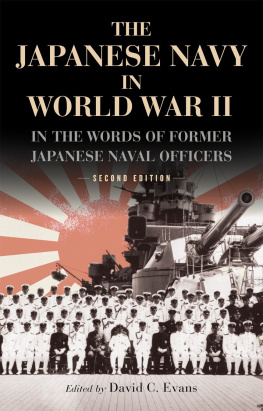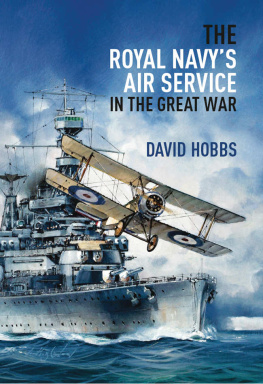Strategy, Tactics, and Technology in the
IMPERIAL JAPANESE NAVY, 1887-1941
David C. Evans Mark R. Peattie
Naval Institute Press Annapolis, Maryland
Naval Institute Press
291 Wood Road
Annapolis, MD 21402
This paperback edition has been brought to publication with the generous assistance of Marguerite and Gerry Lenfest.
This book has been brought to publication with the generous assistance of Edward S. and Joyce I. Miller.
1997 by David C. Evans and Mark R. Peattie
All rights reserved. No part of this book may be reproduced or utilized in any form or by
any means, electronic or mechanical, including photocopying and recording, or by any
information storage and retrieval system, without permission in writing from the publisher.
ISBN 13: 978-0-87021-192-8
First Naval Institute Press paperback edition published 2012.
ISBN 978-1-59114-244-7
The Library of Congress has catalogued the hardcover edition as follows:
Evans, David C.
Kaigun: strategy tactics, and technology in the Imperial Japanese Navy, 1887-1941 /
David C. Evans and Mark R. Peattie.
p. cm.
Includes bibliographical references.
ISBN 0-87021-192-7 (alk. paper)
1. Japan. Kaigun History. I. Peattie, Mark R., 1930. II. Title
VA653.E93 1997
359.00952dc21
97-11455
 This paper meets the requirements of ANSI/NISO z39.48-1992 (Permanence of Paper).
This paper meets the requirements of ANSI/NISO z39.48-1992 (Permanence of Paper).
Printed in the United States of America.
19 18 17 16 15 14 13 12 9 8 7 6 5 4 3 2 1
First printing
To
Admiral Inoue Shigeyoshi
(1889-1975),
professional, patriot, and realist,
and to
Dr. Frederick J. Milford,
whose knowledge, advice, and encouragement have informed
and illuminated this work.
Contents
CREATING A MODERN NAVY
1868-1894 |
FIRST SUCCESS
The Evolution of Japanese Naval Tactics and the Sino-Japanese War, 1894-1895 |
PREPARING FOR BATTLE
Japanese Naval Technology and Doctrine, 1895-1904 |
TRAVAIL AND TRIUMPH
The Japanese Navy and the Russo-Japanese War, 1904-1905 |
SAT TETSUTAR
The Contradictions of Japanese Naval Strategy, 1908-1911 |
TOWARD AN EIGHT - EIGHT FLEET
The Japanese Navys Plans for Expansion, 1905-1922 |
USING A FEW TO CONQUER MANY
The Japanese Navy from the Beginning of the Treaty Era to the First London Naval Conference, 1923-1930 |
OUTRANGING THE ENEMY
The Japanese Navy from the First London Naval Conference to the End of the Treaty Era, 1930-1936 |
TO STRIKE FROM THE SKY
Japanese Naval Aviation, 1920-1941 |
THE BATTLE OF THE SHIPYARDS
Japanese Naval Construction, 1937-1941 |
BEHIND THE FLEET
Collateral Elements of the Japanese Navy, 1937-1941 |
UNEVEN WEAPONS
Submarine, Antisubmarine, and Amphibious Warfare Capabilities in the Japanese Navy, 1937-1941 |
THE GREAT GAMBLE
The Japanese Navy Plans for War, 1937-1941 |
EPILOGUE
Reflections on the Japanese Navy in Triumph and Defeat |
PHOTOGRAPHS
FIGURES
MAPS
As authors, we are by training, experience, and reputation historians of modern Japan. Neither of us is a professional naval officer (though one of us once held a naval commission). Nor are we historians of technology or specialists in any technology that we discuss. Therefore, we owe a great debt to the counsel of true specialists. Without their comments, criticisms, suggestions, and assistance, this work would be a thinner; poorer, and less ambitious undertaking.
First and foremost we must pay tributeno lesser phrase will sufficeto Dr. Frederick J. Milford, one of the two persons to whom we have dedicated this work. Fred Milfords credentials in the sciences, naval matters, and management are not just impressive, they are awesome: a doctorate from MIT; mastery of physics, engineering, and electronics; distinguished naval service; and research and management in the defense industry. His wisdom on various matters scientific and technological has kept us from grounding on the shoals that threaten the novice in these dangerous waters. For scholarship, hard work, and enthusiasm, Milford was our nonpareil of consultants.
Unstinting, too, of his time, attention, and expertise on matters naval and military has been H. P. Willmott, renowned historian of World War II. Ned Willmott read all our chapters, and his extensive critique, marked by wit, erudition, and insight, has demonstrated an extraordinary devotion to our project. If we did not always agree, he usually made us rethink our assumptions and our sentences. Comdr. Alan D. Zimm, USN, Ret., was similarly rigorous and ebullient in his criticism, informed by his familiarity with war-gaming and operational analysis of the Japanese and American navies.
Capt. Yoshida Akihiko, JMSDF, Ret., knows more about the details of the Imperial Japanese Navy than any other individual on either side of the Pacific. His pride in its accomplishments is matched only by his microscopic knowledge of its history and technology. If we erred in stating a measurement, a date, or a place name, Yoshida has been on us like a hawk, serving to remind us that God and the devil are in the details.
Edward S. Miller, acclaimed chronicler and analyst of the American plans for a Pacific war, has also read all our pages and, for each chapter, has offered helpful comment and sage advice. So too has Jon Tetsuro Sumida, one of the most innovative of contemporary naval historians. While our own approach to doing naval history is, to an extent, different from Sumidas, we are quick to acknowledge the formidable challenge he has posed to the accepted concepts and assumptions of the field. Captain Wayne Hughes, USN, Ret., who has brought to his critique of our work a lifetime of thinking about naval tactics, both as a serving naval officer and as one of the faculty of the Naval Postgraduate School at Monterey, has read most of our chapters and has provided helpful comment, as has Professor Clark Reynolds, one of Americas most eminent naval historians. Captain Linton Wells, II, USN, Ret., whose own excellent work in Japanese naval technology is being published by the Naval Institute Press, has taken time out from his heavy responsibilities both at sea and in the Pentagon to offer us advice on a number of our chapters. The doyen of American naval historians, William Braisted, has offered similar help for a number of the earlier chapters of our work. Mark Campbell, an informed young student of navies and naval technology, has been helpful not only through his comments and suggestions concerning portions of the manuscript, but also by the contribution of a number of the diagrams which illustrate our work. We are particularly grateful to Jonathan Parshall who, at the eleventh hour, stepped in to take our maps and many of our illustrations from sketches into publishable form. In the process, he drew on his own considerable knowledge of the Japanese navy to improve them substantially.














 This paper meets the requirements of ANSI/NISO z39.48-1992 (Permanence of Paper).
This paper meets the requirements of ANSI/NISO z39.48-1992 (Permanence of Paper).